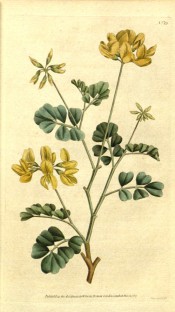Coronilla valentina L. subsp. glauca
Frost-hardy, dense, rounded, compact shrub with pinnate leaves with, usually, 5-7 leaflets, and axillary umbels of 4-14 fragrant, bright yellow flowers in late winter and spring, and again in late summer. To 80cm. The subspecies glauca differs from the type in having only 2-3 pairs of leaflets, blue-green in colour, with a waxy bloom, and lemon-yellow flowers. [RHSE, Hortus, Hilliers’].
Horticultural & Botanical History
Introduced to England in 1722. [PD]. ‘This charming shrub, which is almost perpetually in blossom, and admirably adapted for nosegays, is a native of the south of France, and a constant ornament to our green-houses. Linnaeus has observed, that the flowers, which in the day time are remarkably fragrant, in the night are almost without scent.’ [BM t.13/1787].
History at Camden Park
Listed only in the 1857 catalogue [T.344/1857].
Notes
Published Dec 13, 2009 - 04:37 PM | Last updated Jul 21, 2010 - 11:50 AM
| Family | Fabaceae |
|---|---|
| Category | |
| Region of origin | Southern Europe |
| Synonyms |
|
| Common Name | |
| Name in the Camden Park Record |
Coronilla glauca |
| Confidence level | high |


